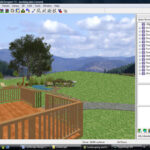Landscaping your backyard to create your own Japanese garden can be easy if you understand the design elements. Japanese gardens have three main elements that are incorporated into the design. The three elements are stones, plants and water.
Stones are used to represent mountains and endurance. When deciding how you want to design your Japanese garden, stones and rocks are the first element that should be placed in the garden before anything else. The shape and size of each stone will determine how it is used in the garden. Typically stones and rocks are used in groups of odd numbers, often to form a triangular shape like a mountain. Stones can be used as a free standing stone structure or sculpture but are also used in the garden as a pathway, bridge, or stepping stones. By using stones in varying sizes and setting it with gravel and sand, pathways can easily be created. The pathways or walkways in a Japanese garden are set and designed in a way to guide the visitor through the different areas of the garden and uneven surfaces in the path or stepping stones are used at points of interest.
Plants help bring out the beauty of the stones in the garden. Unlike the typical garden in America, Japanese gardens do not use plants as the main focus. Flowers are also used sparingly throughout the garden since minimal color is favored. The plants in a Japanese garden should also look as they do in nature and should not look too perfect or manicured. When placing plants try to use various sizes in groupings and not identical sizes which will create straight lines that do not exist in nature. Choose plants that are green throughout the year with a few flowering trees or plants that bloom during the spring season. Common plants used in Japanese gardens include: hydrangeas, chrysanthemums, bush clover, ferns, rhododendrons, asters, dahlias, morning glories, azaleas and camellias. Trees like maples, pines, bamboo, and junipers are also common. The art of bonsai is also used on trees in Japanese gardens but it is not required.
Water represents purity and life and it is also the central point of your garden. Whether the source of water is a pond, a waterfall, or a stream; it must look like a part of the natural setting and not manmade. Ponds and streams must have a natural shape as they do in nature. Waterfalls must also look as they do in nature and cannot be created with fountains. Stone water basins filled with water and hollow bamboo acting as a pipe to drip water into ponds or a basin are decorative pieces often used. Adding koi fish to your pond can add a nice touch. Dry ponds and streams can also be used to represent the water element in a Japanese garden. To create a dry pond or stream you can lay gravel or rake the dirt to look like a moving stream of water. Flat rocks can also be stacked to create a dry waterfall.
Aside from the three main elements in a Japanese garden there are also other features to consider to finish the garden perfectly. Decorative ornaments can be added such stone lanterns, stone or wooden bridges and fences. When using decorative ornaments keep it to a minimum, use them only when necessary to the entire design, and blend it with the natural setting of the garden. Lanterns are used often in Japanese gardens and can be set at the start of a walkway or on turning points of the path. Fencing is also used to help maintain the peaceful and serene environment of the garden. Bamboo or hedge plants are commonly used to create fences.
Finally, keep in mind that the purpose of a Japanese garden is to create a place of harmony, with respect to and appreciation of; nature. Simplicity is important so having many empty spaces throughout the garden is common and expected.
Sources:
diy
Disabled World
essortment
Japanese gardens



